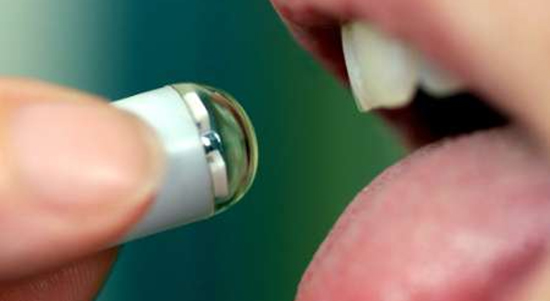The Pill Camera
A pill that takes pics of your insides!

What do my insides look like?
Did you think that camcorders were small enough to fit snugly into the palm of your hand? Read on! Doctors working at hospitals in the USA, England and Australia have been using a tiny video camera that fits snugly into a paracetamol-sized capsule! A patient simply swallows the pill – that is, the camera – and away it goes, snap, snap, snapping shots of your insides and taking the same trip down your insides as food does. Approximately seven hours later, the pill-cam is excreted and that’s the end of it. Being designed for one-use only, there’s no need to fish it out after its trip through your insides!
From entrance to exit
The camera-in-a-pill capsule, or pill-cam, measures 2.5cm by 1.1cm and contains a minuscule digital camera, a light source, and of course a battery to power it up. However, the real genius of the pill-cam lies in its tiny radio transmitter and antenna (also contained in the capsule!) which enables it to transmit data (pictures!) to a data recorder that the patient wears strapped around the waist. From the moment it is swallowed it takes pictures at a rate of two shots every second, right up until the moment it is excreted.
Solving a mystery illness
Tony Hulatt (name changed to respect privacy), a 19-year-old university student was one of the first people in Australia to benefit from using pill-cam technology. Tony had been suffering abdominal pain, anaemia, and bleeding from the bowel for over eighteen months, and had undergone numerous intrusive tests in hospital. Yet none of these tests had been able to identify his mystery illness.
Intrusive tests
 Like other patients with these symptoms, Tony had undergone an endoscopy – an intrusive procedure in which doctors pass a tube down the throat and into the gut to try and see what might be wrong. Tony was also subjected to a colonoscopy, which does the same thing but tries to take a look from the other direction! Neither of these tests could identify his problem.
Like other patients with these symptoms, Tony had undergone an endoscopy – an intrusive procedure in which doctors pass a tube down the throat and into the gut to try and see what might be wrong. Tony was also subjected to a colonoscopy, which does the same thing but tries to take a look from the other direction! Neither of these tests could identify his problem.
We didn’t go far enough …
Gastroenterologists, who analysed the pill cam footage taken from Tony’s pill-cam, said that the problem lay in getting pictures of the small intestine which is about six metres long and lies between the stomach and the large intestine. This makes it really difficult to get clear view of it using a long tube.
Swallowing a pill – less painful than surgery
In the past, doctors have been diagnosing problems associated with the small intestine – such as cancer, ulcers and polyps – by using X-rays or exploratory surgery. These techniques are both unpleasant and painful, as is surgery. The beauty of pill-cam technology is that patients don’t need to go through any special bowel preparation or go under anaesthetic.
Patients can simply swallow the pill-cam in the morning and then go about their normal daily life (even go shopping!) and then return the data recorder to the doctor at the end of the day.
Problem solved!
In Tony’s case the pictures taken by the pill-cam revealed that he had several large ulcers in his small intestine, which explained the pain, the bleeding and his anaemia. With the discovery of what exactly was causing his illness, Tony could stop further painful testing procedures and begin to be treated for his illness – a treatment which thankfully will not involve undergoing a major operation!
So much more to be done . . .
Like any new discovery, the pill-cam has not yet been perfected and there’s much room for improvement. At the moment, the pill-cam is great at identifying a problem, but is unable to estimate its exact position in the body. One of the areas being researched right now involves finding out how to pinpoint the exact location of a problem.
Some amazing facts about the pill-cam
 The pill-cam ‘capsule’ is about the same size as a large multi-vitamin tablet, i.e. 2.5cm x 1cm
The pill-cam ‘capsule’ is about the same size as a large multi-vitamin tablet, i.e. 2.5cm x 1cm
- Two digital images of the intestine lining are taken every second
- The time taken for the pill cam’s entire journey through the body is approx. 7 hours
- Hospitals make use of a computer software programme to speed up viewing the video
- Half of the pill-cam ‘capsule’ consists of batteries
- The miniature lens takes pictures from 2-3cm away
- The tiny Perspex dome over the lens ensures that all images taken are in focus – even when it is touching the wall of the intestine
- The procedure costs about £1000, with the pill-cam itself costing about half that amount
- The official name of the so-called ‘pill-cam’ is the M2A™ Capsule Endoscopy, and it was developed by the Israeli company Given Imaging Ltd.
Activity
Magazine advertisement
Write a 250-word magazine advertisement for the Capsule Endoscope. Think up a brand name and a catchy slogan. Within the advertisement, compare the features of a pill cam to an endoscopy and a colonoscopy (and if you can’t make it sound more attractive, you’re not trying hard enough!) Remember that the procedure is quite expensive, and you’ll have to convince the public it’s good value.
Or
Research at home
Find out more about the technologies that are used in a pill cam – for example:
• Digital recording
• Radio transmission.
Worksheet Pill Cam – the journey
Draw in the organs the pill cam passes through as it goes through the body snapping pics (remember to label all the organs)
Imagine someone has swallowed a pill cam.
Can you name the organs that the pill cam will pass through?
_______________________________________________________________
Print out the image below and use the outline sketch provided to draw in the route the pill cam takes as it travels through various organs on its journey from the mouth to the anus. Draw in and label the organs it passes through.
How does the pill cam travel through the body?
_______________________________________________________________
Could it get stuck? Explain
